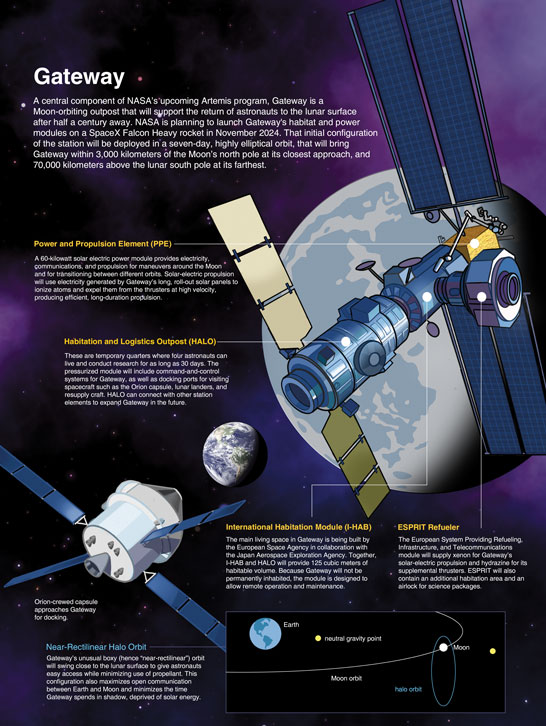
This Article From Issue
September-October 2022
Volume 110, Number 5
Page 264
A central component of NASA's upcoming Artemis program, Gateway is a Moon-orbiting outpost that will support the return of astronauts to the lunar surface after half a century away. NASA is planning to launch Gateway's habitat and power modules on a SpaceX Falcon Heavy rocket in November 2024. That initial configuration of the station will be deployed in a seven-day, highly elliptical orbit, that will bring Gateway with 3,000 kilometers of the Moon's north pole at its closest approach, and 70,000 kilometers above the lunar south pole at its farthest.

Infographic by Gary Schroeder; higher-resolution version.
Power and Propulsion Element (PPE)
A 60-kilowatt solar electric power module provides electricity, communications, and propulsion for maneuvers around the Moon and for transitioning between different orbits. Solar-electric propulsion will use electricity generated by Gateway's long, roll-out solar panels to ionize atoms and expel them from the thrusters at high velocity, producing efficient, long-duration propulsion.
Habitation and Logistics Outpost (HALO)
These are temporary quarters where four astronauts can live and conduct research for as long as 30 days. The pressurized module will include command-and-control systems for Gateway, as well as docking ports for visiting spacecraft, such as the Orion capsule, lunar landers, and resupply craft. HALO can connect with other station elements to expand Gateway in the future.
International Habitation Module (I-HAB)
The main living space in Gateway is being built by the European Space Agency in collaboration with the Japan Aerospace Exploration Agency. Together, I-HAB and HALO will provide 125 cubic meters of habitable volume. Because Gateway will not be permanently inhabited, the module is designed to allow remote operation and maintenance.
ESPRIT Refueler
The European System Providing Refueling, Infrastructure, and Telecommunications module will supply xenon for Gateway's solar-electric propulsion and hydrazine for its supplemental thrusters. ESPRIT will also contain an additional habitation area and an airlock for science packages.
Near-Rectilinear Halo Orbit
Gateway's unusual boxy (hence "near-rectilinear") orbit will swing close to the lunar surface to give astronauts easy access while minimizing use of propellant. This configuration also maximizes open communication between Earth and Moon and minimizes the time Gateway spends in shadow, deprived of solar energy.

American Scientist Comments and Discussion
To discuss our articles or comment on them, please share them and tag American Scientist on social media platforms. Here are links to our profiles on Twitter, Facebook, and LinkedIn.
If we re-share your post, we will moderate comments/discussion following our comments policy.